Chevrolet Cobalt Owners Manual: Removing the Flat Tire and Installing the Spare Tire (SS Model)
The SS Model has larger performance brakes than the base model. The compact spare tire will not clear the front brakes.
Do not use the compact spare tire in the event of a front flat tire.
You must use the rear tire to replace the front flat tire.
To change the rear road tire:
Rear Tire Changing Procedure
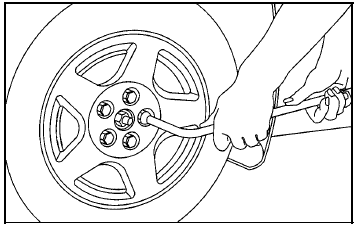
1. Do a safety check before proceeding.
See Changing a Flat Tire for more information.
2. If your vehicle has plastic wheel covers, use the wheel wrench to loosen the plastic wheel nut caps.
Once the plastic wheel nut caps have been loosened with the wheel wrench, you can finish loosening them with your fingers. The plastic nut caps do not come off.
3. If necessary, use the flat end of the wheel wrench to pry along the edge of the rear wheel cover until it comes off.
Store the wheel cover in the trunk until the flat tire is repaired or replaced.
4. Use the wheel wrench to loosen all the rear wheel nuts. Do not remove them yet.
Notice: Make sure that the jack lift head is in the correct position or you may damage your vehicle.
The repairs would not be covered by your warranty.
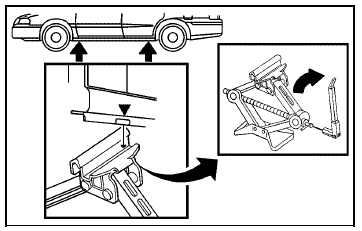
5. Position the jack lift head at the rear jack location nearest the rear tire. The rear location is about 4 inches (10 cm) in front of the rear wheel opening.
6. Raise the jack head until it fits firmly in the vehicle's frame, where the notch is located, nearest the flat tire.
7. Put the compact spare tire near the rear tire.
WARNING:
Getting under a vehicle when it is jacked up is
dangerous. If the vehicle slips off the jack, you
could be badly injured or killed. Never get under a
vehicle when it is supported only by a jack.
WARNING:
Raising your vehicle with the jack improperly
positioned can damage the vehicle and even
make the vehicle fall. To help avoid personal
injury and vehicle damage, be sure to fit the jack
lift head into the proper location before raising the
vehicle.
8. Raise the vehicle by turning the jack handle clockwise. Raise the vehicle far enough off the ground so there is enough room for the compact spare tire to fit under the vehicle.
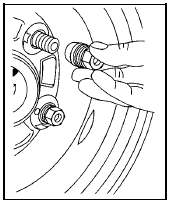
9. Remove all of the
wheel nuts.
WARNING:
Rust or dirt on a wheel, or on the parts to which it
is fastened, can make wheel nuts become loose
after time. The wheel could come off and cause
an accident. When changing a wheel, remove any
rust or dirt from places where the wheel attaches
to the vehicle. In an emergency, use a cloth or
a paper towel to do this; but be sure to use a
scraper or wire brush later, if needed, to get all
the rust or dirt off. See Changing a Flat Tire.
10. Place the compact spare tire on the wheel-mounting surface.
WARNING:
Never use oil or grease on bolts or nuts because
the nuts might come loose. The vehicle's wheel
could fall off, causing a crash.
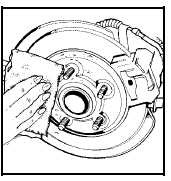
11. Remove any rust or dirt
from the wheel bolts,
mounting surfaces,
and spare wheel.
Reinstall the wheel nuts with the rounded end of the nuts toward the wheel. Tighten each nut by hand until the wheel is held against the hub.
12. Lower the vehicle by turning the jack handle counterclockwise. Lower the jack completely.
WARNING:
Wheel nuts that are improperly or incorrectly
tightened can cause the wheels to become
loose or come off. The wheel nuts should be
tightened with a torque wrench to the proper
torque specification after replacing. Follow the
torque specification supplied by the aftermarket
manufacturer when using accessory locking
wheel nuts. See Capacities and Specifications for original equipment wheel nut
torque specifications.
Notice: Improperly tightened wheel nuts can lead to brake pulsation and rotor damage.
To avoid expensive brake repairs, evenly tighten the wheel nuts in the proper sequence and to the proper torque specification. See Capacities and Specifications for the wheel nut torque specification.
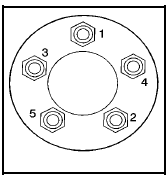
5-Wheel Nuts
13. Tighten the wheel nuts
firmly in a crisscross
sequence, as shown.
Notice: Wheel covers will not fit on your vehicle's compact spare. If you try to put a wheel cover on the compact spare, the cover or the spare could be damaged.
To change the front flat tire:
Front Flat Tire Changing Procedure:
1. Perform a rear tire change by removing the rear tire and installing the compact spare tire in the rear wheel location. The rear road tire will be used to replace the front flat tire. See Rear Tire Changing Procedure in this section.
2. Do a safety check before proceeding.
See Changing a Flat Tire.
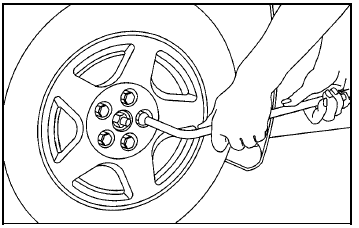
3. If your vehicle has plastic wheel covers, use the wheel wrench to loosen the plastic wheel nut caps.
Once the plastic wheel nut caps have been loosened with the wheel wrench, you can finish loosening them with your fingers. The plastic nut caps do not come off.
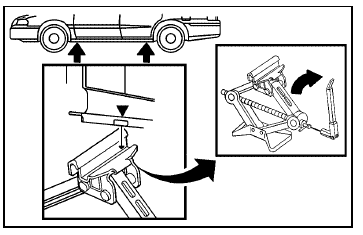
4. If necessary, use the flat end of the wheel wrench to pry along the edge of the wheel cover until it comes off.
Store the wheel cover in the trunk until the flat tire is repaired or replaced.
5. Use the wheel wrench to loosen all the wheel nuts on the flat tire. Do not remove them yet.
6. Position the jack lift head at the jack location nearest the flat tire. The front location is about 8 inches (20 cm) behind the front wheel opening.
Notice: Make sure that the jack lift head is in the correct position or you may damage your vehicle.
The repairs would not be covered by your warranty.
7. Raise the jack head until it fits firmly in the vehicle's frame, where the notch is located, nearest the flat tire.
8. Put the tire near the flat tire.
WARNING:
Getting under a vehicle when it is jacked up is
dangerous. If the vehicle slips off the jack, you
could be badly injured or killed. Never get under
a vehicle when it is supported only by a jack.
WARNING:
Raising your vehicle with the jack improperly
positioned can damage the vehicle and even
make the vehicle fall. To help avoid personal
injury and vehicle damage, be sure to fit the jack
lift head into the proper location before raising the
vehicle.
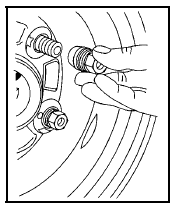
9. Raise the vehicle by turning the jack handle clockwise. Raise the vehicle far enough off the ground so there is enough room for the compact spare tire to fit under the vehicle.
10. Remove all of the
wheel nuts.
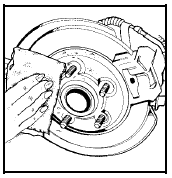
9. Raise the vehicle by turning the jack handle clockwise. Raise the vehicle far enough off the ground so there is enough room for the compact spare tire to fit under the vehicle.
10. Remove all of the
wheel nuts.
WARNING:
Rust or dirt on a wheel, or on the parts to which it
is fastened, can make wheel nuts become loose
after time. The wheel could come off and cause
an accident. When changing a wheel, remove any
rust or dirt from places where the wheel attaches
to the vehicle. In an emergency, use a cloth or
a paper towel to do this; but be sure to use a
scraper or wire brush later, if needed, to get all
the rust or dirt off. See Changing a Flat Tire.
12. Place the tire on the wheel-mounting surface.
WARNING:
Never use oil or grease on bolts or nuts because
the nuts might come loose. The vehicle's wheel
could fall off, causing a crash.
13. Reinstall the wheel nuts with the rounded end of the nuts toward the wheel. Tighten each nut by hand until the wheel is held against the hub.
14. Lower the vehicle by turning the jack handle counterclockwise. Lower the jack completely.
WARNING:
Wheel nuts that are improperly or incorrectly
tightened can cause the wheels to become
loose or come off. The wheel nuts should be
tightened with a torque wrench to the proper
torque specification after replacing. Follow the
torque specification supplied by the aftermarket
manufacturer when using accessory locking wheel
nuts. See Capacities and Specifications for original equipment wheel nut
torque specifications.
Notice: Improperly tightened wheel nuts can lead to brake pulsation and rotor damage.
To avoid expensive brake repairs, evenly tighten the wheel nuts in the proper sequence and to the proper torque specification. See Capacities and Specifications for the wheel nut torque specification.
15. Tighten the wheel nuts
firmly in a crisscross
sequence, as shown.
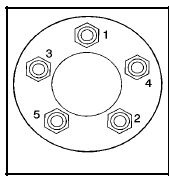
5-Wheel Nuts
Notice: Wheel covers will not fit on your vehicle's compact spare. If you try to put a wheel cover on the compact spare, the cover or the spare could be damaged.
 Removing the Flat Tire and Installing the Spare Tire (All Models Except SS)
Removing the Flat Tire and Installing the Spare Tire (All Models Except SS)
1. Do a safety check before proceeding.
See Changing a Flat Tire.
2. If your vehicle has plastic wheel covers, use the
wheel wrench to loosen the plastic wheel nut caps.
Once the plastic wheel n ...
 Storing a Flat or Spare Tire and Tools
Storing a Flat or Spare Tire and Tools
WARNING:
Storing a jack, a tire, or other equipment in the
passenger compartment of the vehicle could
cause injury. In a sudden stop or collision, loose
equipment could strike someone. Store all t ...
See also:
Chevrolet Cobalt Owners Manual. Setting the Clock
Without Date Display
AM/FM Base Radio with a Single CD Player
To set the time:
1. Turn the ignition key to ACC/ACCESSORY or
ON/RUN. Press O to turn the
radio on.
2. Press until the hour
begins flashing on the
display. Press a second time
and the minute
begins flashing on the display.
...
Chevrolet Cobalt Owners Manual
- In Brief
- Seats and Restraint System
- Features and Controls
- Instrument Panel
- Driving Your Vehicle
- Service and Appearance Care
- Maintenance Schedule
- Customer Assistance Information
Chevrolet Cobalt Service Manual
- Air Bags
- Air Conditioning & Heater
- Body & Frame
- Brakes
- Cooling System
- Driveline
- Electrical
- Electronic Stability Controls
- Engine Service
